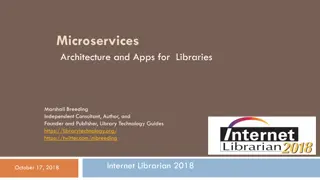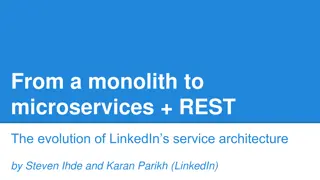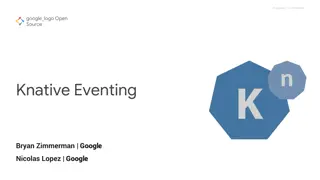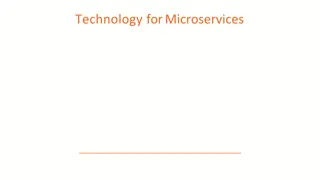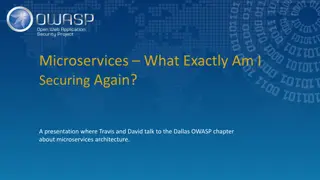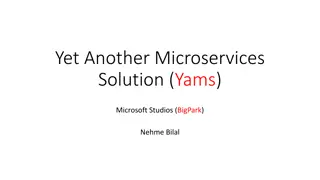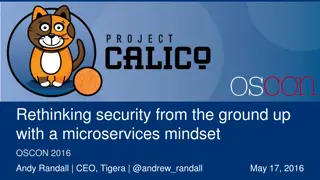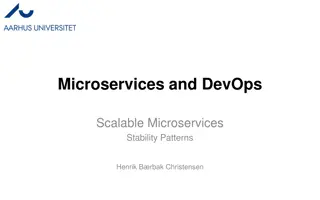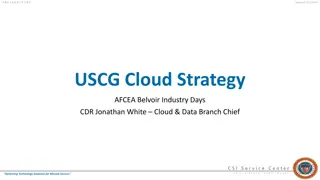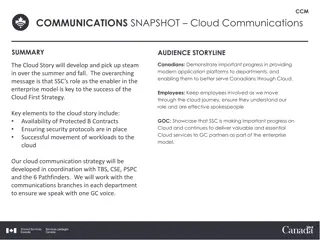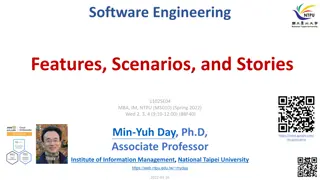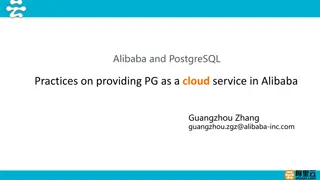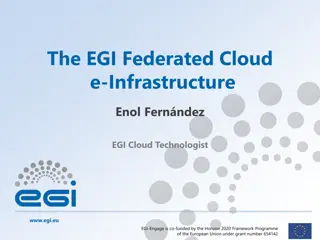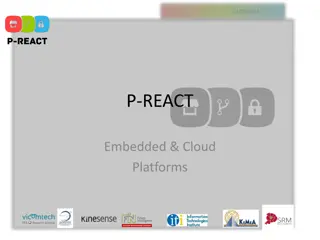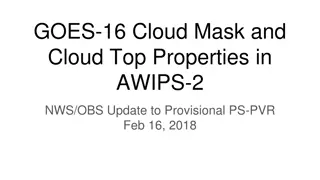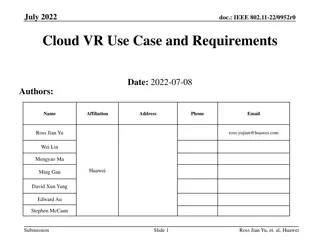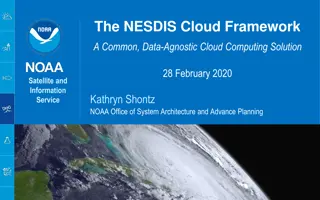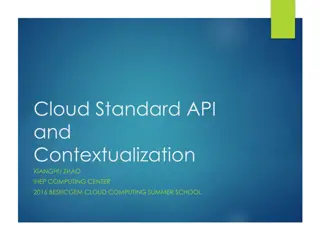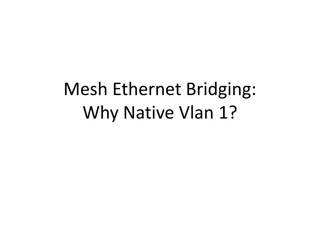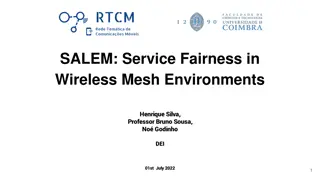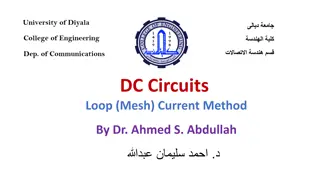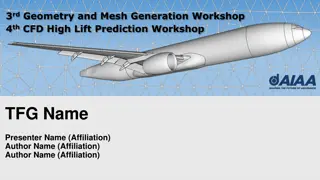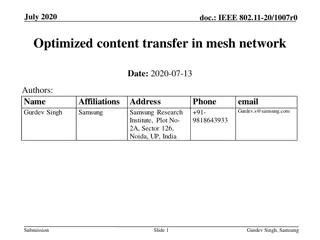Understanding Microservices and Service Mesh in Modern Cloud Architecture
Exploring the concepts of microservices and service mesh as crucial components in the evolution of cloud computing. Learn about the benefits of microservices architecture, the necessity of service mesh in managing complexity, and popular tools like Linkerd, Istio, and Envoy. Dive into the application architecture, deployment processes, and the fundamental differences between monolithic and microservices-based systems. Discover what true microservice architectures entail with examples like Twitter and Amazon Web Services.
Download Presentation

Please find below an Image/Link to download the presentation.
The content on the website is provided AS IS for your information and personal use only. It may not be sold, licensed, or shared on other websites without obtaining consent from the author. Download presentation by click this link. If you encounter any issues during the download, it is possible that the publisher has removed the file from their server.
E N D
Presentation Transcript
Service Mesh: a New Infrastructure Layer Under Microservices www.leannet.eu
$> whoami PhD in Telecommunications @ Budapest University of Technology Worked with 5G technology SDN & NFV Cloud Native Network Functions Graduated in the EIT Digital Doctoral School Co-founder & CTO @ LeanNet Ltd. Consulting, training, implementing Cloud Native, Microservices, DevOps megyesi@leannet.eu twitter.com/M3gy0 linkedin.com/in/M3gy0 www.leannet.eu
Outline Basics of service mesh The evolution of cloud computing Microservices leading to complexity The necessity of a new architectural component The sidecar proxy deployment strategy Data plane vs. control plane in a service mesh Choices for realizing a service mesh Linkerd Linkerd2 (the current version) Envoy as the universal dataplane for Istio AWS App Mesh Consul Kuma 3 hour tutorial tomorrow: Linkerd & Istio! www.leannet.eu
Application Architecture Deployment & Packaging Application Infrastructure Development Process Waterfall Monolithic Psychical Servers Server Room Agile SOA Virtual Machines Data Center (IaaS) Time DevOps Microservices Containers Cloud Platform Cloud Native www.leannet.eu
What are Microservices? Microservices architecture is software development form that structures an application as a collection of loosely coupled services having bounded context, which implement business capabilities. Microservices enable the continuous delivery/deployment of large, complex applications. Monolithic software Vertically scalable Hard to maintain and evolve Very long build / test / release cycles Always fixing bugs Lack of innovation Service Oriented Architecture Microservices Horizontally scalable Services are easy to maintain Very short build / test / release cycles Easy to innovate www.leannet.eu
This is not a Microservice Architecture! Web Server App Server DB Server www.leannet.eu
This is Getting There. www.leannet.eu
But These are True Microservice Architectures! Twitter Amazon Web Service www.leannet.eu
But These are True Microservice Architectures! www.leannet.eu
Monolith vs. Microservices? Complex application Easy networking Easy applications (services) Complex networking The fallacies of distributed computing: The network is reliable Latency is zero Bandwidth is infinite The network is secure Topology doesn't change There is one administrator Transport cost is zero The network is homogeneous https://en.wikipedia.org/wiki/Fallacies_of_distributed_computing www.leannet.eu
What is a Service Mesh? Service Mesh is dedicated infrastructure layer in a microservices environment to consistently manage, monitor and control the communication between services across the entire application www.leannet.eu
Evolution: LAMP to Web Scale PHP SVC Apache PHP MySQL Nginx DB SVC Apache PHP MySQL Nginx DB SVC Apache PHP MySQL Nginx DB SVC PHP SVC www.leannet.eu
Evolution: Common Features in DevSecOps Dynamic service discovery Load balancing Health checks Timeouts Retries Circuit breakers Traffic encryption (mTLS) Fine-grained access control Access auditing Rate limiting Rewrites and redirects Consistent metrics Access logs Distributed tracing Fault injection www.leannet.eu
Evolution: Shared Libraries to Service Mesh Examples for such fat libraries: Hystrix @ Netflix Stubby @ Google Finagle @ Twitter SVC Nginx DB SVC Disadvantages of shared libraries: Have to be implemented in multiple languages If the library changes the entire service has to be redeployed Too tight involvement of dev teams Nginx DB SVC Nginx DB SVC SVC Library www.leannet.eu
Linkerd A service mesh that adds reliability, security, and visibility to cloud native applications Official CNCF Project Originally created by Buoyant Inc. based on Finagle Written in JAVA This is the control plane that programs the individual dataplane proxies These are the dataplane components (proxies) namerd www.leannet.eu
Sidecar Model in Container Environments Disadvantages of per-node model Raises security concerns in multi-tenant environments (shared TLS secrets, common authentication, etc.) Can only be scaled vertically, not horizontally (give it more memory and CPU and it will handle more connection) Not optimized for container workloads Proxy Proxy Proxy Proxy Proxy Proxy Proxy Proxy Proxy Proxy Proxy Proxy Node 1 Node 2 Node 3 The sidecar model Put a proxy next to every container This is supported by the POD abstraction in Kubernetes Linkerd is considered to be too heavy for such environment! www.leannet.eu
Linkerd2 (previously know as Conduit) A novel service mesh that was specifically designed to work in Kubernetes Created by Buoyant, the same team who created Linkerd Data plane is written in Rust to be very fast and lightweight to sidecar operations (~5MB container size) Control plane is written in GO to work well in Kubernetes Can be deployed service-by-service (it s not an all-or-nothing choice ) www.leannet.eu
Envoy Envoy is an open source edge and service proxy, designed for cloud-native applications Official CNCF Project Originally created by Lyft Written in C++ Out of process architecture with advanced threading Best in class observability Rich APIs called xDS Features include L3/L4 filter and routing architecture HTTP L7 filter architecture First class HTTP/2 support gRPC support MongoDB and DynamoDB L7 support www.leannet.eu
Istio A service mesh control plane which uses Envoy as data plane Originally created by Google and IBM Written in GO Provides core features for: Traffic management Observability Security Has four main components Pilot for managing and configuring the Envoy proxies Mixer for providing policy controls and telemetry collection Citadel for service-to-service and end-user authentication Galley for configuration validation, ingestion, processing and distribution www.leannet.eu
Istio vs. Linkerd2 Somewhat easy to install Hard to operate Heavy control plane Advanced data plane (Envoy) Has a built in ingress (and egress) controller (Envoy) Doesn t have a dashboard (but Kiali can be one) Monitoring: Service graph S2S latency Response codes Jaeger Tracing Advanced HTTP routing: Blue/Green Canary Dark launch Very easy to install Easy to operate Light control plane Very light data plane (in Rust) No ingress included Has a dashboard Monitoring: Service graph S2S latency Response codes No tracing Very basic HTTP routing: No Blue/Green Canary No dark launch www.leannet.eu
Other Examples Envoy based Non-Envoy based synaps www.leannet.eu
Okay, But Should I Use a Service Mesh??? It depends Not a good reason: I ve heard it s cool since Google made this! Want to be cloud native so I must use this new stuff My boss told me But definitely use it if: You have micro(ish)services environment, written in multiple languages, and you need consistent telemetry You need mTLS for every service-to-service communication You have a microservices environment where some service are failing, and you can t figure out which one of them You need to apply more advance deployment patterns (e.g. canary, blue/green), since you current one is too slow www.leannet.eu


